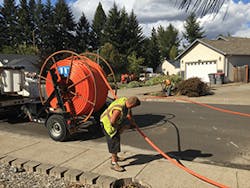Latest from FTTx/Optical Networks
The Requirement of Innovation
The first requirement of innovation is you must become comfortable with being uncomfortable. You define an audacious goal and then you courageously step forward into the unknown.
Here at OnlineNW, we have embraced a culture of innovation. Our audacious goal is to create a technical, financial and market development model that will allow us to quickly build world-class fiber networks in small rural communities.
We believe our rural communities are truly our country’s heartland. If we can successfully connect these communities, using high-speed fiber networks, we can give those communities the new opportunities of an emerging global digital economy. By doing that, we can help unleash the creative genius of these communities in a way that would have a generational impact that reaches far beyond their borders.
We fully recognize that the elements of this model are extremely challenging. Building a fiber plant is expensive and difficult. Further, rural communities are geographically dispersed, creating significant backhaul challenges. And, far from urban cores, the demand drivers for high-speed connectivity in these markets are often less developed.
We are using one community, Dayton, Oregon, for our prototype. From there we are architecting our model to allow us to quickly scale to other communities.
Dayton is a small agricultural community with 2,500 people. As with many rural communities, it has been economically struggling. Two-thirds of the students in its school live in poverty. It is also culturally diverse, with over a third of its student population being Hispanic.
We have a long history as a WISP in Oregon’s Willamette Valley, covering over 2,500 square miles with our fixed wireless service since 2005. To support our redundant licensed links for our tower backhauls, and for redundant links with our upstream providers, we began to build a fiber network in 2013. At first, the construction of this network was contracted out, but we quickly realized that bringing this construction expertise in-house would be essential for a sustainable cost model. So we began to significantly invest in both the construction equipment and staff training needed to build these networks.
Fiber construction in Dayton, Oregon.
The "How" Behind the Goal
Fiber is an essential element of our long-term strategy. By combining new expertise in this area with our existing expertise in fixed wireless and DSL, we significantly increase our ability to creatively develop elegant network solutions in complex environments.
Additional keys to our fiber network architecture design are simplicity and flexibility. Our base platform is the ADTRAN TA5000/5006 with Gen 1 GPON cards using B+ optics that will be upgraded with a 4 port XGS-PON card as our network demand increases.
We built 7 Clearfield pedestals/cabinets positioned throughout the town with 1×32 or Dual 1×16 splitters. Each pedestal/cabinet also has a cartridge of 1×2 splitters that allows for additional flexibility (1×16, 1×32, 1×48, or 1×64 splits are all possible). We use the TA411 Micro ONT for the CPE.
Mainline segments through a town are typically 144- or 96-count fiber to both serve the GPON customers and allow for pass-through transit to other locations. We try to use the length of the MST tails to minimize feeder fiber into a neighborhood or cul-de-sac. The feeders are typically 24- or 48-count. Duraline 1-1/4" HDPE w/silicor is our primary path for the underground fiber, with 17"x30" vaults for splice cases and small plastic or polymer concrete for the MSTs. We use the Clearfield microduct with pre-made pushable fiber for most underground installations, while favoring traditional flat-drop with wedge clamps and a splice for the aerial installs.
The $$$ Behind the Goal
We are a small company without VC or private equity backing — and building fiber networks is expensive. To finance these networks, we depend on bank loans from local community banks. As a result, we needed to develop a model to manage this financial risk, both for ourselves and for our bank.
A key piece of this financial equation is what is called the coverage ratio, that is calculated by the revenue generated by the investment divided by the loan servicing costs. Most banks require a projected coverage ratio of at least 1.2 in order for a loan to be considered; that is, you are projected to kick-off at least 20% more revenue than the cost of the loan over its term.
You have 2 key drivers of this equation, then: the cost of the network construction and the projected revenue. To make this model work, we targeted a cost per home passed below $700. To reach this goal, we needed to tightly manage the costs of both the aerial and underground components of our plant build.
While our aerial costs are lower, during our build-out we experienced significant delays with the make-readies that challenged our construction timelines. We also found that, given our resources, it was more efficient to contract that work out while we focused our 2 construction teams on the underground build. Our teams are extremely motivated and efficient, and we have been able to primarily bore rather than trench these connects. As a result, we have been able to achieve a construction cost for the mainline below $10/ft.
But in order for this financial model to work, we needed to quickly achieve a take-rate for the network that generated the necessary revenue to cover the loan payments. Here is where we had to develop a particularly innovative approach. And it began with a question as simple as What if?
What if we partnered with the local school district to make this new fiber network integral — not only for local infrastructure development, but also for their talent and business development strategies in the community? In so doing, this network might become a part of a much larger story that had the students and community members help us sign-up new subscribers, and include a commitment on our part to provide a revenue sharing agreement to support the innovation initiatives in their school and community.
Working in partnership with Innovate Oregon, we were able to quickly put this model in place with the community and define a targeted take-rate of 40%. This take-rate would not only provide us the revenue we needed to cover our loan, but also provide a significant annual investment back into their new Innovation Fund.
One Goal Met. The Next?
Now that the fiber network is almost built in Dayton, we are getting ready to move on to our next community. Two communities, Amity and Willamina, are vying to become the next Innovate city powered with a new fiber network.
While in Dayton, we were able to use one of our nearby lines to backhaul with fiber as these two communities are more isolated. As a result, our plan is to build-out a city fiber plant via that initial backhaul through a licensed wireless link. This backhaul architecture will allow us to quickly build gigabit fiber service for their community at a reasonable cost per home passed. We will then have time to explore creatively co-funding a fiber backhaul with potentially either government or foundation support.
As anyone in the industry knows, building world-class Internet networks is not for the faint of heart. It requires significant risk and bold initiatives. To be successful, we need to develop new partnerships and re-image the possible. But this work is important, as it lays the core foundation for our economic future.
OnlineNW, a regional WISP, is heavily investing in building out rural fiber networks that includes the West Coast’s first 10 Gig fiber network in Dayton, Oregon. This showcase project includes a long-term revenue sharing plan with the local school district to support their i3 Center and other innovation initiatives.
Save
Save






